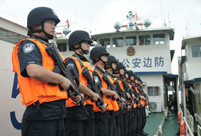 'Jin' named the word of the year by cross-strait netizens
'Jin' named the word of the year by cross-strait netizens Chinese scientific expedition goes to build new Antarctica station
Chinese scientific expedition goes to build new Antarctica station
 Chinese naval escort fleet conducts replenishment in Indian Ocean
Chinese naval escort fleet conducts replenishment in Indian Ocean 17th joint patrol of Mekong River to start
17th joint patrol of Mekong River to start China's moon rover, lander photograph each other
China's moon rover, lander photograph each other Teaming up against polluters
Teaming up against polluters
BEIJING, Dec. 25 -- In 2013, China continued to promote the internationalization of the yuan, or Renminbi, with media and analysts buzzing about the effect of recent reforms on the increasingly global currency.
The country made progress in facilitating RMB-denominated international trade and investment, developing RMB offshore businesses, and establishing more currency swap lines and other financial agreements.
Financial reform measures announced in the last two months by China, especially a 30-point guideline issued by the central bank to support the country's first free trade zone in Shanghai, are set to help speed up RMB internationalization.
Media outlets worldwide hyped the news that the RMB had overtaken the euro and become the second-most used currency in global trade finance. Of much more significance, however, are figures related to actual trade settlement in yuan.
According to global transaction services organization SWIFT, the RMB remained the 12th payments currency in the world, with a mere 0.84 percent share of all global payments in October, even lower than the Thai baht and Swedish krona.
In comparison, the U.S. dollar and the euro accounted for 38.1 percent and 34.7 percent of all global payments, respectively, followed by 9.9 percent for the British pound.
China is the world's second-largest economy after the U.S. It is the world's largest exporter and second-largest importer of goods. The international use of the RMB is not at all commensurate with the importance of China's economic status.

 People prepare for upcoming 'Chunyun'
People prepare for upcoming 'Chunyun'  Highlights of Beijing int'l luxury show
Highlights of Beijing int'l luxury show Record of Chinese expressions in 2013
Record of Chinese expressions in 2013 China's moon rover, lander photograph each other
China's moon rover, lander photograph each other 17th joint patrol of Mekong River to start
17th joint patrol of Mekong River to start Spring City Kunming witnesses snowfall
Spring City Kunming witnesses snowfall Heritage of Jinghu, arts of strings
Heritage of Jinghu, arts of strings Weekly Sports Photos
Weekly Sports Photos PLA elite units unveiled
PLA elite units unveiled  China's stealth fighters hold drill over plateau
China's stealth fighters hold drill over plateau Chinese navy hospital ship's mission
Chinese navy hospital ship's mission  "Free lunch" program initiated in NW China
"Free lunch" program initiated in NW China  Rime scenery in Mount Huangshan
Rime scenery in Mount Huangshan DPRK's Kaesong Industrial Complex
DPRK's Kaesong Industrial Complex 'Jin' named the word of the year
'Jin' named the word of the year Day|Week|Month